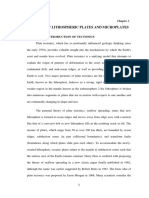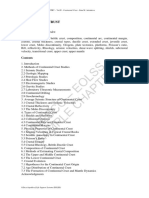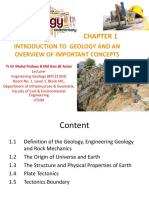General Introduction: 1.1 Definitions and Concept
General Introduction: 1.1 Definitions and Concept
Uploaded by
Franklyn FrankCopyright:
Available Formats
General Introduction: 1.1 Definitions and Concept
General Introduction: 1.1 Definitions and Concept
Uploaded by
Franklyn FrankOriginal Title
Copyright
Available Formats
Share this document
Did you find this document useful?
Is this content inappropriate?
Copyright:
Available Formats
General Introduction: 1.1 Definitions and Concept
General Introduction: 1.1 Definitions and Concept
Uploaded by
Franklyn FrankCopyright:
Available Formats
Shell Intensive Training Programme General Introduction
Geophysics
1.
General Introduction
1.1 Definitions and Concept
Geophysics is the science that applies the principles of physics to the study of the Earth (usually the earth subsurface). In order to achieve this, measurements are s made at or near the earth surface to obtain data arising from the vertical and/or s lateral variations of the distribution of subsurface physical properties of earth materials (rocks and minerals). The interpretation of this data is capable of detecting and delineating local and regional features that could be of economic interest and/or aid in the unravelling of the Earth interior. Most geologic features that would be of s economic interest as natural resource comprise the concentrations of specific minerals or pore fluids. Such concentrations are not usually common in nature. Hence geophysics seeks to detect areas of this UNCOMMON concentrations usually referred to as ANOMALIES. Geophysical method of subsurface investigation provides a relatively rapid and costeffective means of deriving large area information coverage of subsurface geology. Although geophysical data can sometimes be prone to ambiguities and uncertainties of interpretation, the only better alternative is drilling of boreholes and wells and this is very expensive in comparative terms and also drilling provides subsurface information ONLY at discrete locations. Geophysical exploration for subsurface resources is however not an exclusive alternative to drilling but when properly applied can optimise exploration programmes by reducing wildcat drilling and the incidence of dry holes to the barest minimum. While the main thrust of exploration geophysics is to detect and delineate both salient and large scale features, instrumentation and operations for large scale studies such as the internal structure of the earth differ in design and usage from that required for the search for natural resources of the upper crust which is relatively small scale. Before getting into the different scales and methods of geophysical studies it is necessary to take a quick review of the internal structure of the earth as obtained from seismological studies of earthquakes.
Okueze, E
Page 1 of 5
Univation
Shell Intensive Training Programme General Introduction
Geophysics
1.2
Internal Structure of the Earth
The analysis of seismological data recorded from earthquake waves, (fig 1.1) shows that the Earth is internally made up of 3 principal regions CRUST, MANTLE and CORE.
Fig. 1.1 (a) Earthquake wavefronts and raypaths for direct P-waves. (b) Raypaths for some reflected and refracted waves, illustrating wave nomenclature.
This study is usually referred to as Earthquake seismology. The recording and analysis of resulting seismic waves from earthquakes especially since the 1906 San Francisco Earthquake shows a whole range of variations of the physical properties of Okueze, E Page 2 of 5 Univation
Shell Intensive Training Programme General Introduction
Geophysics
the rocks of the Earth with depth (P and S- wave velocities, density, pressure and temperature), (Fig. 1.2).
Fig. 1.2 Earth-layering.(a) Terminology. (b) Variation of physical properties with depth within the earth. P= pressure in 1011 Pa, =density in g/cm3, =S-wave velocity in km/s,
=P-wave velocity in km/s, G= gravity in Gal, T=temperature in K. Dashed curve
represents solidus in the core (Sheriff, 1999).
Mohorovicic in 1909 detected an interface boundary from his analysis where P-wave velocities increased remarkably known as the Moho (i.e. the Mohorovicic discontinuity )at a depth range of 10 to 40km. Gutenberg also detected another major discontinuity in 1913 at approximately 2850km depth. Interestingly he discovered that S-value reduced to almost half while densities shot up almost three times at this boundary known as the Gutenberg discontinuity. While the Moho defined the boundary between the Crust and the Mantle, Gutenberg defined that between the mantle and the core. However, 2 main transition zones were interpreted to occur at 900km depth (dividing the mantle into upper and lower) and at 5000km depth marking the end of the Outer core as different from the Inner core. Okueze, E Page 3 of 5 Univation
Shell Intensive Training Programme General Introduction
Geophysics
At Gutenberg boundary, S-waves stopped propagating and P-wave velocity reduced to a half. This phenomenon has been interpreted to mean that the waves encountered a liquid medium at this depth and hence the Outer core is believed to be liquid. At the 5000km depth, Lehmann analysis in 1936 showed that P-wave s velocities shot up again to about 1.5 of its value indicating a solid medium once again as the Inner core. It was also observed that other physical properties increased gradually from this 5000m depth till the centre of the Earth at about 6400km depth. The crust and the Mantle are further grouped into 3 subdivisions the Lithosphere (which is cold, rigid and brittle) at 0-125km depth; the Astemosphere (which is warm, mobile and plastic) between 125-250km depth; and the Mesosphere (which is highly dense, has high temperature and pressure and is basically non-magnetic) is at a depth range of 250-2850km. TheMoho which is the lowermost boundary of the crust lies at about 10km depth at its shallowest point beneath the deep ocean basins within the Pacitic abyssal plains and up to 40-50km depth at its thickest area within the continental area of the Hymalayas in Asia. The interaction of the warm and mobile Astemosphere, which is continuously in a convective motion with the overlying cold, rigid, and brittle Lithosphere, gives rise to the major geologic processes which have shaped the Earth surface since the s beginning of time. Volcanic eruptions, Earthquake phenomenon, ocean basins and mountain chains are all part of and the result of the Astermosphere-Lithosphere interaction now generally referred to as Plate Tectonics. Further details of these phenomena and the internal structure of the Earth are discussed in Lowrie (1997). Incidentally, in all the depths of the Earth, all exploration activities for natural resources take place within just about the first 10km of the crust. Natural resources where they occur are formed through various geologic processes many of which are exclusive. In other words, resources such as coal or hydrocarbons do not form during processes that can form minerals such as Olivines, Cassiterites, quartz etc. While volcanic activities give rise to the formation of the above minerals, sedimentation, diagenesis and time give rise to the formation of coal and hydrocarbons. Therefore distribution of natural resources is not arbitrary but well organised and structured. All successful applications of geophysical investigations for subsurface Okueze, E Page 4 of 5 Univation
Shell Intensive Training Programme General Introduction
Geophysics
resources must then take into account the regional and/or local geologic setting. Exploration for coal or hydrocarbons should take place within sedimentary basins while the search for Olivines, Felspar, Cassiterite etc should be concentrated in basement regions.
Okueze, E
Page 5 of 5
Univation
You might also like
- Foxes Book of MartyrsDocument257 pagesFoxes Book of MartyrsMarc LaBarbera100% (2)
- Crude Oil Emulsions - Petroleum Engineers Handbook PDFDocument34 pagesCrude Oil Emulsions - Petroleum Engineers Handbook PDFMichael Grayson100% (3)
- Well Performance EquationsDocument21 pagesWell Performance EquationsFranklyn Frank100% (1)
- Water-Injection Pressure Maintenance and Water Flood ProcessesDocument52 pagesWater-Injection Pressure Maintenance and Water Flood ProcessesFranklyn Frank83% (6)
- The Basics of Geology PDFDocument113 pagesThe Basics of Geology PDFManzoor NoumanNo ratings yet
- 1698310542-Reading Assignment 1 - GeologyDocument12 pages1698310542-Reading Assignment 1 - GeologyRaihan FadelNo ratings yet
- MODULE 1 - Monday 5-11-2012 EVOLUTION OF GEOMORPHOLOGYDocument63 pagesMODULE 1 - Monday 5-11-2012 EVOLUTION OF GEOMORPHOLOGYStephen ErickNo ratings yet
- 1 Evidence For Earth's Crust, Mantle & CoreDocument12 pages1 Evidence For Earth's Crust, Mantle & CoreNaga NagendraNo ratings yet
- Geology For Forestry StudentsDocument103 pagesGeology For Forestry StudentsMadan ThapaNo ratings yet
- IntroductionDocument7 pagesIntroductionنور الهدى احمد بشير A 50No ratings yet
- Michael NewsViews Nature 2011Document2 pagesMichael NewsViews Nature 2011eepoporkaaNo ratings yet
- 4 CIV2102 Minerals and Geological MaterialsDocument53 pages4 CIV2102 Minerals and Geological MaterialsamanyaNo ratings yet
- Concept of Lithospheric Plates and MicroplatesDocument11 pagesConcept of Lithospheric Plates and MicroplatesAwais Leghari100% (1)
- Contiental Crust CompositionDocument10 pagesContiental Crust CompositiondeshmukhgeolNo ratings yet
- UNIT-1 General Geology: Geology in Civil EngineeringDocument23 pagesUNIT-1 General Geology: Geology in Civil EngineeringKarnalPreethNo ratings yet
- GeologyDocument41 pagesGeologycarlafaith06No ratings yet
- C1 GeoDocument46 pagesC1 GeoAfiq IrfanNo ratings yet
- GeologicalSocietyLondonSpecialPublications 2014 Roberts SP389.13Document17 pagesGeologicalSocietyLondonSpecialPublications 2014 Roberts SP389.13retheesh sugunanNo ratings yet
- GEY - 103-Introduction To Geology Full NoteDocument60 pagesGEY - 103-Introduction To Geology Full Noteabuabdmuqseet2001No ratings yet
- Madda Walabu University Engineering College: Department of Civil EngineeringDocument25 pagesMadda Walabu University Engineering College: Department of Civil EngineeringRina DedefoNo ratings yet
- GEOLOGYDocument10 pagesGEOLOGYDAIS, MANDO FRED AGUITINGNo ratings yet
- 1 Introuction: Regional Landforms Analysis: The Nature of Geomorphology DefinitionsDocument18 pages1 Introuction: Regional Landforms Analysis: The Nature of Geomorphology DefinitionsRoni Hepson TambunNo ratings yet
- Structural Geology of The Earth's Exterior-1979-BurchfielDocument7 pagesStructural Geology of The Earth's Exterior-1979-BurchfielSuta VijayaNo ratings yet
- Engineering Encyclopedia: Introduction To GeologyDocument63 pagesEngineering Encyclopedia: Introduction To GeologykarimirelayNo ratings yet
- Geology For Engineers (Sci 3) : Earth Structure and Composition BSCE 2B and 2C Engr. Jovin ManarinDocument26 pagesGeology For Engineers (Sci 3) : Earth Structure and Composition BSCE 2B and 2C Engr. Jovin ManarinJovin ManarinNo ratings yet
- 1 - Basins in Their Plate Tectonic Environment - 2012Document42 pages1 - Basins in Their Plate Tectonic Environment - 2012Eri Sarmantua Sitinjak100% (1)
- Introduction To GeologyDocument1 pageIntroduction To GeologyAnesu SakalaNo ratings yet
- GeophysicsDocument14 pagesGeophysicsbilal kabooNo ratings yet
- Geology Chapter 2 - EditedDocument57 pagesGeology Chapter 2 - Editedalonsoaliko72No ratings yet
- (P) - Physiography of The Ocean Basins: CHAPTER 10: Introduction To The LithosphereDocument4 pages(P) - Physiography of The Ocean Basins: CHAPTER 10: Introduction To The LithosphereJabran KhanNo ratings yet
- The Earth: Surface, Structure and Age: Table 1Document4 pagesThe Earth: Surface, Structure and Age: Table 1KrisNo ratings yet
- PT-2103 Geo (S)Document17 pagesPT-2103 Geo (S)raospoorthi09No ratings yet
- TurbiditasDocument14 pagesTurbiditasSoraya Alejandra Castro MuñozNo ratings yet
- Plate Tectonics-Lectures in Astrobiology-MartinDocument13 pagesPlate Tectonics-Lectures in Astrobiology-MartinNyemer BaruelNo ratings yet
- Rudnick 95Document43 pagesRudnick 95Willam CarNo ratings yet
- Ch. 01 - Geology - Part 1Document36 pagesCh. 01 - Geology - Part 1Theresa DaherNo ratings yet
- Plate TectonicsDocument87 pagesPlate TectonicsAspiron Hangibayna KussitaNo ratings yet
- Byju'S Ias: Unit TestDocument24 pagesByju'S Ias: Unit TestResolution Plan CompetitionNo ratings yet
- Chapter Two: The Geology of Ethiopia and The HornDocument63 pagesChapter Two: The Geology of Ethiopia and The HornAbineh TilahunNo ratings yet
- Geology Chapter 1Document25 pagesGeology Chapter 1abd.ra707No ratings yet
- Engineering GeologyDocument269 pagesEngineering GeologyEl Patrick100% (2)
- Lecture #1 & 2 The Dynamic EarthDocument77 pagesLecture #1 & 2 The Dynamic EarthezansahizzahNo ratings yet
- Geography Study Guide With AnswersDocument8 pagesGeography Study Guide With AnswersScribdTranslationsNo ratings yet
- Geology - WikipediaDocument125 pagesGeology - WikipediaCabar KennethNo ratings yet
- Neptel BookDocument345 pagesNeptel BookWanly Pereira100% (1)
- Across-Arc Geochemical Trends in The Izu-Bonin Arc: Contributions From The Subducting Slab, RevisitedDocument27 pagesAcross-Arc Geochemical Trends in The Izu-Bonin Arc: Contributions From The Subducting Slab, RevisitedAbhinav PandeyNo ratings yet
- Earth Science or Geoscience Includes All Fields of Natural Science Related To The Planet EarthDocument3 pagesEarth Science or Geoscience Includes All Fields of Natural Science Related To The Planet EarthGalicinao Christine RaineNo ratings yet
- © Ncert Not To Be Republished: Nterior OF THE ArthDocument9 pages© Ncert Not To Be Republished: Nterior OF THE ArthdukkasrinivasflexNo ratings yet
- Delamination of Oceanic Lithosphere in SW Iberia: A Key For Subduction Initiation? (EGU2019-6001)Document1 pageDelamination of Oceanic Lithosphere in SW Iberia: A Key For Subduction Initiation? (EGU2019-6001)kevinward2023No ratings yet
- Geomorphology: Definition, Nature and Scope: A ReviewDocument4 pagesGeomorphology: Definition, Nature and Scope: A ReviewShifat AkashNo ratings yet
- جيولوجيا عامة محاضرة 1Document29 pagesجيولوجيا عامة محاضرة 1nopn0481No ratings yet
- Europa's Crust and OceanDocument14 pagesEuropa's Crust and Oceanmaneesh_massey_1No ratings yet
- Takashima CretaceousEnvironmentalChangesDocument5 pagesTakashima CretaceousEnvironmentalChangesJacqueline FernandezNo ratings yet
- EGE 112 Physical Geography I Notes - May-August 2021 SemesterDocument102 pagesEGE 112 Physical Geography I Notes - May-August 2021 SemesterderrosammaNo ratings yet
- (PT) (Gufenberg) Earth PhysicsDocument5 pages(PT) (Gufenberg) Earth Physicsjcb1961No ratings yet
- Tektonik IndonesiaDocument8 pagesTektonik IndonesiaArfaq Fauqi RomadlonNo ratings yet
- Isacks Et Al., 1968Document45 pagesIsacks Et Al., 1968Tania G VerdiguelNo ratings yet
- 1 s2.0 S0921818121000394 MainDocument14 pages1 s2.0 S0921818121000394 MainSAMER ALJURFNo ratings yet
- Geog - Affr.Horn Chapter 2Document59 pagesGeog - Affr.Horn Chapter 2deepblue5991No ratings yet
- Geology Module 1Document15 pagesGeology Module 1Yashawanth Chavan100% (1)
- On the Origin of Continents and Oceans: Book 2: The Earths Rock RecordFrom EverandOn the Origin of Continents and Oceans: Book 2: The Earths Rock RecordNo ratings yet
- Ocean Biogeochemistry: The Role of the Ocean Carbon Cycle in Global ChangeFrom EverandOcean Biogeochemistry: The Role of the Ocean Carbon Cycle in Global ChangeNo ratings yet
- Geology: A Fully Illustrated, Authoritative and Easy-to-Use GuideFrom EverandGeology: A Fully Illustrated, Authoritative and Easy-to-Use GuideRating: 3.5 out of 5 stars3.5/5 (10)
- CSC461-Objected Oriented ProgrammingDocument52 pagesCSC461-Objected Oriented ProgrammingFranklyn Frank100% (1)
- Cumm 080Document23 pagesCumm 080Diah Ayu SulistyowatiNo ratings yet
- Healing MinistryDocument38 pagesHealing MinistryFranklyn FrankNo ratings yet
- Residue and Virtue "Understanding The Importance of Consecration"Document5 pagesResidue and Virtue "Understanding The Importance of Consecration"Franklyn FrankNo ratings yet
- General Introduction: 1.1 Definitions and ConceptDocument5 pagesGeneral Introduction: 1.1 Definitions and ConceptFranklyn FrankNo ratings yet
- The Egyptian GodsDocument2 pagesThe Egyptian GodsFranklyn FrankNo ratings yet
- Vectors and Its RepresentationsDocument2 pagesVectors and Its RepresentationsFranklyn FrankNo ratings yet
- 40 - Estimation of Oil and Gas ReservesDocument38 pages40 - Estimation of Oil and Gas Reservesrizal tri susilo50% (2)
- 55 - Formation FracturingDocument12 pages55 - Formation Fracturingrizal tri susiloNo ratings yet
- Engineering HandBookDocument80 pagesEngineering HandBookFranklyn FrankNo ratings yet
- Electric Submersible PumpsDocument17 pagesElectric Submersible PumpsFranklyn Frank100% (3)
- Surface Facilities For Waterflooding and Saltwater Disposal.Document34 pagesSurface Facilities For Waterflooding and Saltwater Disposal.Franklyn Frank100% (5)
- Development Plans For Oil and Gas ReservoirsDocument11 pagesDevelopment Plans For Oil and Gas ReservoirsFranklyn FrankNo ratings yet
- Crude Oil Properties and Condensate Properties and CorrelationsDocument20 pagesCrude Oil Properties and Condensate Properties and CorrelationsFranklyn FrankNo ratings yet
- CT Safety ManualDocument36 pagesCT Safety ManualFranklyn Frank100% (1)
- Thermal Recovery: Steam DisplacementDocument46 pagesThermal Recovery: Steam DisplacementFranklyn FrankNo ratings yet
- Training ManualDocument295 pagesTraining ManualFranklyn Frank0% (1)
- 58 - The SI Metric System of Units and SPE Metric StandardDocument39 pages58 - The SI Metric System of Units and SPE Metric Standardrizal tri susiloNo ratings yet

















































































